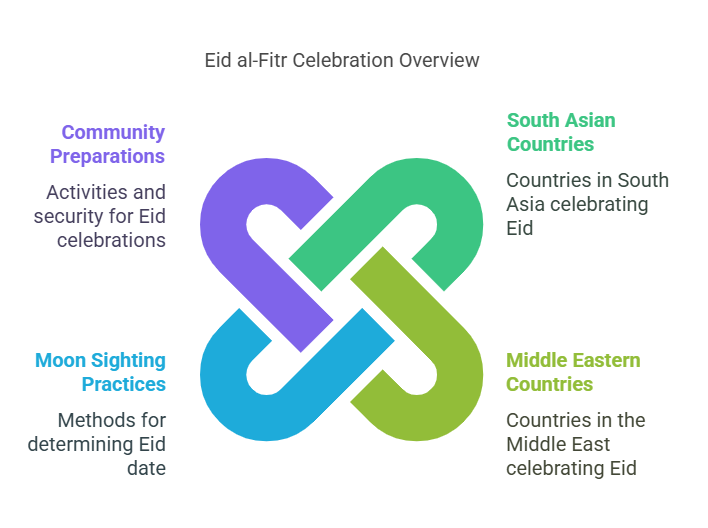As the holy month of Ramadan comes to a close, Muslim-majority countries and communities around the world have begun observing the sky for the sighting of the Shawwal crescent moon, a critical event that marks the end of Ramadan and the beginning of Eid al-Fitr. While this festival is celebrated across the globe with great spiritual and cultural significance, the exact date of Eid can vary depending on local moon sightings. This year, the variation has once again been observed, with different countries announcing different dates for Eid.
Saudi Arabia and Gulf Nations Celebrate Eid on March 30, 2025
The Kingdom of Saudi Arabia announced the official sighting of the Shawwal crescent moon on the evening of Saturday, March 29, 2025. As a result, Saudi Arabia will celebrate Eid al-Fitr on Sunday, March 30. This early sighting is in line with several other Gulf nations including Qatar, the United Arab Emirates (UAE), Bahrain, and Kuwait, who also confirmed the visibility of the crescent and declared Sunday as the first day of Shawwal.
The sighting of the moon was confirmed by the Saudi Supreme Court, which traditionally relies on local sightings by trusted witnesses in various regions of the country. The announcement triggered celebrations across the Kingdom, with mosques preparing for special Eid prayers and families finalizing preparations for the holiday.
Australia, Malaysia, and Brunei to Observe Eid on March 31, 2025
In contrast to the Gulf countries, Australia has confirmed that the crescent moon was not sighted on Saturday evening, and therefore Ramadan will complete 30 days. Eid al-Fitr in Australia will be observed on Monday, March 31, 2025. The Australian Fatwa Council stated that the decision is based on both local moon visibility and astronomical calculations.
Malaysia and Brunei have also announced that they will celebrate Eid on March 31. According to their respective Islamic authorities, the first day of Shawwal will fall on Monday. Both countries began fasting on March 2, 2025, making Ramadan 29 days long. Officials from Malaysia’s Department of Islamic Development (JAKIM) emphasized that the moon was not visible on March 29 and thus confirmed the holiday for the following day.
South Asia and the Middle East Also Announce Eid on March 31
Similarly, South Asian countries such as Bangladesh, India, and Pakistan, as well as Middle Eastern nations like Iran and Oman, have declared that Eid al-Fitr will be celebrated on Monday, March 31, 2025. These countries generally adhere to local moon sightings or rely on regional astronomical calculations.
In Bangladesh, the National Moon Sighting Committee met on Saturday evening but did not receive credible reports of the moon being seen anywhere in the country. Consequently, Ramadan will complete 30 days and Eid will be celebrated on Monday. Indonesia’s Ministry of Religious Affairs has also confirmed the same schedule after failing to observe the crescent moon on Saturday.
In India and Pakistan, the Central Ruet-e-Hilal Committees declared that the Shawwal crescent was not sighted and Ramadan would continue for a full 30 days. Large gatherings are expected for Eid prayers in open grounds and mosques across these countries, with security preparations and community events already underway.
United Arab Emirates: Conflicting Reports on Eid Date
Interestingly, in the UAE, there were initial conflicting reports regarding the Eid date. While the government later confirmed March 30 as Eid al-Fitr, local media outlets like Gulf News had earlier quoted astronomical experts suggesting that Ramadan might end on March 30, making Eid fall on March 31. These forecasts, however, were overruled by official moon sighting declarations from the UAE Moon Sighting Committee on Saturday evening.
Understanding the Lunar-Based Islamic Calendar
The Islamic calendar is based on the lunar cycle, consisting of 12 months of 29 or 30 days, depending on the sighting of the moon. The beginning and end of each month are marked by the appearance of the new crescent moon. Therefore, the length of Ramadan and the timing of Eid can vary across different regions.
Moon sighting plays a pivotal role in determining Islamic dates, and while some countries rely on actual visual sightings, others use scientific calculations. This dual approach can lead to variations, as seen in 2025. Despite these differences, the spiritual essence of Eid remains consistent across cultures and communities.
Cultural and Religious Significance of Eid al-Fitr
Eid al-Fitr, also known as the “Festival of Breaking the Fast,” is one of the most important Islamic holidays. It is a time of communal prayers, family gatherings, festive meals, and charitable giving. The day begins with a special prayer service called Salat al-Eid, held in mosques and open fields. Worshippers dress in their finest clothes, often new or freshly cleaned, and come together to thank Allah for granting them the strength to complete the month of fasting.
One of the fundamental aspects of Eid is giving Zakat al-Fitr, a form of charity required of all Muslims who can afford it. This act ensures that even those in need can participate in the festivities. Eid is also marked by cultural customs that differ by country, including unique dishes, sweets, and family traditions.
Unity in Diversity
While the exact day of Eid al-Fitr may differ based on geographic location and moon visibility, the unity of the Muslim world in observing this sacred festival remains intact. Whether celebrated on March 30 or March 31, 2025, the essence of Eid—gratitude, generosity, family, and faith—resonates with Muslims everywhere. As the crescent moon ushers in a new month, it brings with it a message of hope, renewal, and unity.









































